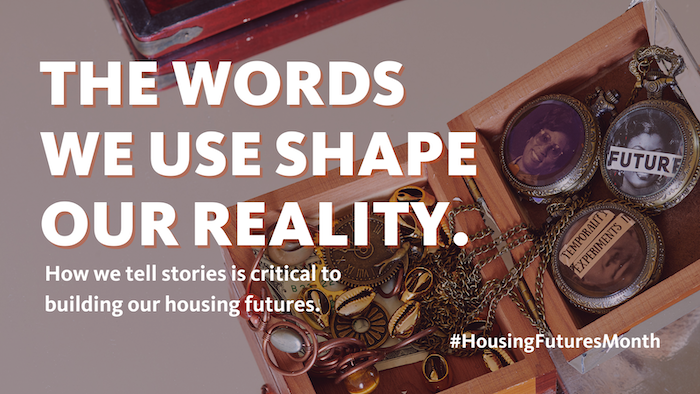Things That Make a Difference: Housing Futures Month and Narrative

Black Quantum Futurism, Ancestors Returning Again/This Time Only to Themselves exhibition, photo by Albert Yee (Philadelphia, 2021)
by Laura Hughes, Director of Narrative Strategies
Narratives are the stories we tell that help us make sense of the world. We use storytelling in all its forms, from gossip with our best friends to bedtime stories with our nieces and nephews. And, most importantly, stories tell where we are today and shape the world we want to create. As Director of Narrative Strategies at PolicyLink, I am keenly aware that our narrative—how we tell stories—is critical to building our housing futures.
My day-to-day involves serving coalitions pursuing rent stabilization, advocating at the intersection of housing and climate justice, and platforming those experiencing housing instability—all of whom are storytellers. I have learned first-hand from the HENS (Housing Equity Now Saint Paul) Keep St. Paul Home Rent Stabilization campaign as they brilliantly told the stories of individuals who have chosen to live together as a family and are deeply invested in their neighborhoods—a group of people that we might otherwise refer to as renters. They told stories that demonstrated the power of looking across the street and seeing a neighbor instead of trying to decipher if they were a renter or an owner. They made visible landlords who saw housing as a basic need instead of out-of-town corporate interests who didn’t care about residents.
From helping shape a vision for “housing for all” to calling on local, state, and federal government leaders to shape policy solutions, our most powerful leaders are our greatest storytellers. In fact, these leaders appear to seamlessly weave an equitable future into stories that our base, persuadables, and even our greatest opponents, have to wrestle with. The greatest storytellers integrate methodologies from the fields of applied behavioral science, human-centered design, and behavioral economics to offer unique insights for dramatically improving the persuasive power of the stories we tell. As we dream and pursue bold futures for housing, here are three things that will make a difference as we shape our narrative and tell stories for a housing foundation on which health is built; where families and communities thrive; and where our experiences with housing are liberatory.
Protagonist
As we build our housing futures, we must reimagine how we collaborate with impacted people and communities to build sustainable power. Black, Brown, and Indigenous communities must be centered as protagonists in our narrative. As we pursue policies, it means positioning those who are the closest to the problem, as the closest to the solution. It means recognizing the barriers that are baked into our system as structural inequalities. It means utilizing an anti-racist lens as we design. It means centering those who are disproportionately affected by housing instability at the center of envisioning and creating these new worlds and new futures. It means allowing those with lived experience to tell their own stories. For some of us, this may mean opening the metaphorical “door” and moving aside to allow those with lived experience to go first.
Messaging Inevitability
As we build our bright and bold housing futures, shift our language to the place of inevitability. Black, Brown, and Indigenous communities know exactly what the pulse of joy feels like. From phrases of “we are our ancestor’s greatest dreams,” to unapologetically thriving, shift our language to match. Eliminate “if” from your vocabulary and replace it with “when.” When every tenant has the right to counsel, no family will ever be evicted in less than a 15-minute proceeding. When eviction diversion and meditation programs are standards of well-being, no child will ever have to wonder where they will sleep at night. When the Tenant Opportunity to Purchase Act (TOPA) is adopted, everyone has the chance to be a first-time homebuyer.
Words Shape Reality
The words we use shape our reality. If we tell a story the same way enough times, we internalize it as reality. So, imagine with me, what will it feel like when the well-being of our neighborhoods is measured by the health, safety, and affordability of housing? Interrogate and choose asset-based language for your storytelling. Inspire action in your storytelling by starting with the golden circle of why, how, and what.
We believe that bright and bold housing futures for our communities mean new models and approaches that are unapologetically inclusive of all and imagined and made possible by the brilliance, insights, and guidance from the communities most impacted by housing inequities. Join us.